Common Email Marketing Mistakes and How to Avoid Them!
Email marketing remains a cornerstone of digital marketing
strategies, but many businesses fall prey to common pitfalls that hinder their
success. In this guide, we'll explore the most prevalent email marketing
mistakes and provide actionable tips on how to avoid them.
1. Neglecting Email Content Optimisation:
Email campaigns are only as effective as the content they
deliver. Neglecting email content optimisation can lead to lacklustre results
and low engagement rates.
What to do:
To address this issue, focus on email content optimisation
by conducting A/B testing on subject lines, experimenting with different
content formats, and incorporating visually appealing elements such as images
or videos. Craft personalised content that speaks to your audience's pain
points and interests, and ensure that your CTAs are clear and compelling.
Regularly analyse engagement metrics to identify areas for improvement and
refine your content strategy accordingly.
2. Overlooking Email Personalisation:
Personalisation is key to successful email marketing.
Universally applicable, standardised emails are not likely to be well-received
by your audience.
What to do:
Combat this mistake by leveraging email personalisation
tools and techniques, such as dynamic content blocks and merge tags, to tailor
your emails to each recipient's preferences and behaviour. Segment your
audience based on demographics, purchase history, and engagement level, and
deliver targeted content that resonates with their interests. Engage
subscribers with personalised recommendations, exclusive offers, and relevant
updates to foster a deeper connection with your brand.
3. Ignoring Email Engagement Metrics:
Email engagement metrics provide valuable insights into the
effectiveness of your campaigns. Ignoring these metrics can prevent you from
identifying areas for improvement and optimising your email marketingstrategies.
What to do:
Stay proactive by regularly monitoring key email engagement
metrics and using them to inform your decision-making process. Identify trends
and patterns in your data, such as high-performing subject lines or
underperforming content, and adjust your strategies accordingly. Experiment
with different approaches to optimise your campaigns for maximum engagement and
conversion rates, and continuously refine your tactics based on the insights
gained from your metrics.
4. Failing to Segment Your Email List:
Segmentation is essential for delivering targeted and
relevant content to your subscribers. Failing to segment your email list can
result in poor engagement and high unsubscribe rates.
What to do:
Take a strategic approach to email list segmentation by
dividing your audience into distinct groups based on relevant criteria such as
demographics, geographic location, purchase history, or engagement behaviour.
Customise your messaging and content for each segment to ensure relevance and
resonance, and use automation tools to streamline the segmentation process. By
delivering targeted content to specific segments, you can increase engagement
and drive better results.
5. Spamming Your Subscribers' Inboxes:
Sending too many emails or irrelevant content can quickly
lead to your emails being marked as spam or unsubscribed.
What to do:
Avoid email spamming by adhering to best practices for email
frequency and relevance. Develop a content calendar to plan your email cadence
and ensure that each communication provides genuine value to your subscribers.
Segment your audience to deliver more targeted and personalised content, and
respect unsubscribe requests for any newsletter marketing promptly to maintain
trust and credibility. By respecting your subscribers' inbox space, you can
foster a positive relationship and avoid being labelled as spam.
6. Neglecting Mobile Optimisation:
With the majority of emails now being opened on mobile
devices, neglecting email mobile optimisation can be a costly mistake.
What to do:
Prioritise email mobile optimisation by designing responsive
email templates that adapt seamlessly to various screen sizes and devices.
Optimise your email layouts, fonts, and images for mobile viewing, and test
your emails across different devices and email clients to ensure compatibility.
Pay attention to loading times and ensure that your CTAs are easily clickable
on mobile devices to provide a smooth user experience. By catering to the
growing number of mobile users, you can maximise engagement and conversion
rates.
7. Relying Solely on Email Automation:
While email automation can streamline your marketing efforts
and save time, relying solely on automated emails can lead to a lack of
personalisation and human touch.
What to do:
Strike a balance between email automation and manual
outreach to maintain a human touch and foster authentic connections with your
audience. Use automation to streamline repetitive tasks such as welcome emails,
birthday greetings, or abandoned cart reminders, but supplement automated
emails with personalised messages and email outreach efforts. Engage with
subscribers on a personal level, respond to enquiries promptly, and nurture
leads through targeted follow-ups to build trust and loyalty over time.
8. Choosing the Wrong Email Marketing Platform:
Selecting the right email marketing platform is crucial to
the success of your campaigns. Choosing a platform that doesn't align with your
needs or lacks essential features can hinder your efforts.
What to do:
Ensure that you select the right email marketing platform by
evaluating your specific needs and objectives. Research different platforms
based on factors such as features, pricing, scalability, integration options,
and customer support. Look for platforms that offer robust analytics and
reporting tools, advanced segmentation capabilities, and intuitive design
interfaces. Consider your long-term growth strategy and choose a platform that
can accommodate your evolving needs and scale your business effectively. By
selecting the right platform from the outset, you can streamline your email
marketing efforts and drive better results.
Conclusion
By avoiding these common email marketing mistakes and
implementing best practices, you can maximise the effectiveness of your
campaigns and drive better results. Remember to prioritise email engagement,
personalise your content, monitor performance metrics, and choose the right
tools and strategies for your business. With careful planning and execution,
you can unlock the full potential of email advertising and achieve your
marketing goals.




Comments
Post a Comment